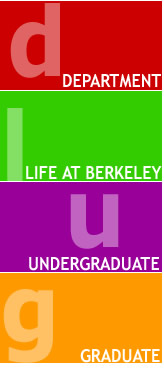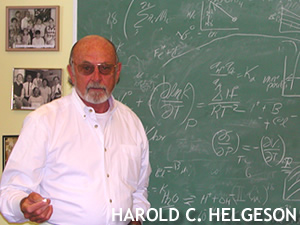

 |
|
|
Hal's Teaching and Research at Berkleley 2002 My focus in teaching at Berkeley continues to be centered around grounding the students in fundamentals that are essential to understanding the subject matter and applying it to the best advantage possible in his or her future career. For example, in lecture courses I try to make complex subjects understandable by using familiar examples and humor to get the concepts across. I make the environment informal on a first name basis and constantly encourage student participation. In one of my courses, equations play a major role in the learning process. I try to make the equations palatable by using structural models to demonstrate what they represent and I explain why we need them, what they are telling us, and how we can use them to advantage in research. I employ thought experiments, together with computers to get the points across. It has become increasingly challenging in recent years to educate students in the classroom because they are coming more and more from diverse educational backgrounds. As a result I strive to fill in the gaps of basic knowledge in such a way that the students are not embarrassed, but rather find their interest kindled by recognition that we all need to go back to basics from time to time, and that most concepts are indeed relatively simple if perceived with insight (which I try to impart) using the chemical, physical, and mathematical tools that are suitable for the problem at hand. I attempt to demonstrate ways in which these tools can be identified and applied in a variety of ways within the context of the course material and how that material relates to the broader fields of science. I stress the interdisciplinary nature of the subject matter and the need to be exact in our explanations of physical and chemical phenomena. My philosophy in training my graduate students to be professional Ph. D. scientists and educators centers around the concept of apprenticeship. I treat them as equals, meet with them weekly, and interact with them daily. We discuss the challenge at hand and the chances of successfully solving problems in the broader context of the overall objectives of their thesis research. I suggest avenues of approach and explicitly guide the student, but at the same time I encourage the student to fill in the gaps, think about the problem, and come back the next day or week with new ideas. I encourage them to take challenging graduate courses related to their research and explain to me how what they learn in the courses can be used to advantage in our research. Hence, our interaction is a two-way street and we both learn in the process. I say "our" research because I participate actively in facilitating and helping the student progress toward successful and innovative research accomplishment. Creative input comes from both directions. As a consequence, when it comes time to publish the research, we do it jointly, but always with the new Ph.D. as the senior author. My own research career has evolved enormously over the past several years, with increasing emphasis on biogeochemistry and the organic-inorganic interface in geochemical processes. The discovery of microbial life in hydrothermal systems at temperatures in excess of 110 degrees centigrade has forever changed the notion that biomacromolecules degrade under extreme conditions. In fact, it has profound interdisciplinary implications, not only with respect to biogeochemistry and the organic-inorganic interface in geologic systems, but also in biotechnology, drug design, genetic engineering, and other fields in the medical sciences. It is only now becoming widely recognized that enzymes function much longer with greater catalytic efficiency at high temperatures. With funding from NSF, I have been addressing these issues from a fundamental point of view by developing global equations of state for protein unfolding as a function of temperature, pH, and solution composition. Thermodynamic calculations we have carried out using these equations of state have led to a new theory of biomacromolecular stability that strongly supports the hypothesis that life on Earth originated in the high-temperature deep biosphere in the upper mantle. The equations of state for protein unfolding are currently being written up for publication. At the same time, a new research project is getting under way to use the equations of state and Gibbs free energy minimization calculations to investigate with the aid of computer experiments the chemical and thermodynamic factors that stabilize enzymes in extreme environments. This research will lead to Jeff Dick's Ph.D. dissertation. A new grant proposal has been submitted recently to NSF requesting support for this research. Another avenue of research being actively pursued in my laboratory with NSF support is thermodynamic characterization at high temperatures of DNA and RNA, both of which are fundamental to replication, storage, and flow of genetic information in hyperthermophilic microbes. Toward that end, calorimetric data are being analyzed theoretically to determine numerical values of the group contributions, nearest neighbor interactions, and thermodynamic parameters for new equations of state which can be used to calculate the relative stabilities of nucleic acid bases, nucleosides, nucleotides, RNA, and both single- and double-stranded DNA at high temperatures. Doug LaRowe is spearheading this research, which will constitute the basis of his Ph.D dissertation. Other research
being carried out in my laboratory is concerned with the origin
and chemical evolution of petroleum in the Earth. As a result of
a comprehensive effort over the past decade to calculate the thermodynamic
properties of the myriad of hydrocarbon species and other organic
compounds found in kerogen, bitumen, and crude oil, this research
is now beginning to accelerate. Recently we discovered that reaction
of water with kerogen in hydrocarbon source rocks increases the
oil generation potential of the kerogen. In addition, the results
of computer experiments we have carried out over the past several
years strongly support the hypothesis that high molecular weight
n-alkanes, isoprenoids, diterpanes, steranes, hopanes, and aromatic
compounds in kerogen are in metastable equilibrium with hydrocarbons
in crude oil with carbon numbers greater than ~ 6 - 10, depending
on the bulk composition. These calculations have led to a chemical
and thermodynamic model of oil generation accompanying organic metamorphism
in subsiding hydrocarbon source rocks. We have recently demonstrated
that this model can account for all of the oil production in the
Paris Basin, North Sea, and other major oil fields. For example,
we predict total production of 28 million bbls of oil per square
km (72.5 million bbls per square mile) from a 20-meter thick source
rock devoid of water at a depth of 5 km and 150 degrees centigrade.
In accord with typical high-production source rocks in sedimentary
basins, the model source rock contains 10 percent reactant organic
carbon (ROC) in type II kerogen with H/C = 1.3. The calculations
indicate that oil generation in this source rock results in minimum
expulsion of ~18 percent, or 5 million bbls per square km (13 million
bbls per square mile) from the source rock, which is nearly twice
the reported richness of the entire Los Angeles basin! Although
the model needs refining, we find it to be a profound discovery
that has far-reaching implications with respect to future exploration
and development of hydrocarbon resources. My postdoctoral fellow
Laurent Richard is assisting with this research, which is being
supported by funds provided by a grant from the Department of Energy. |
 |
||||||||||
 |
||||||||||